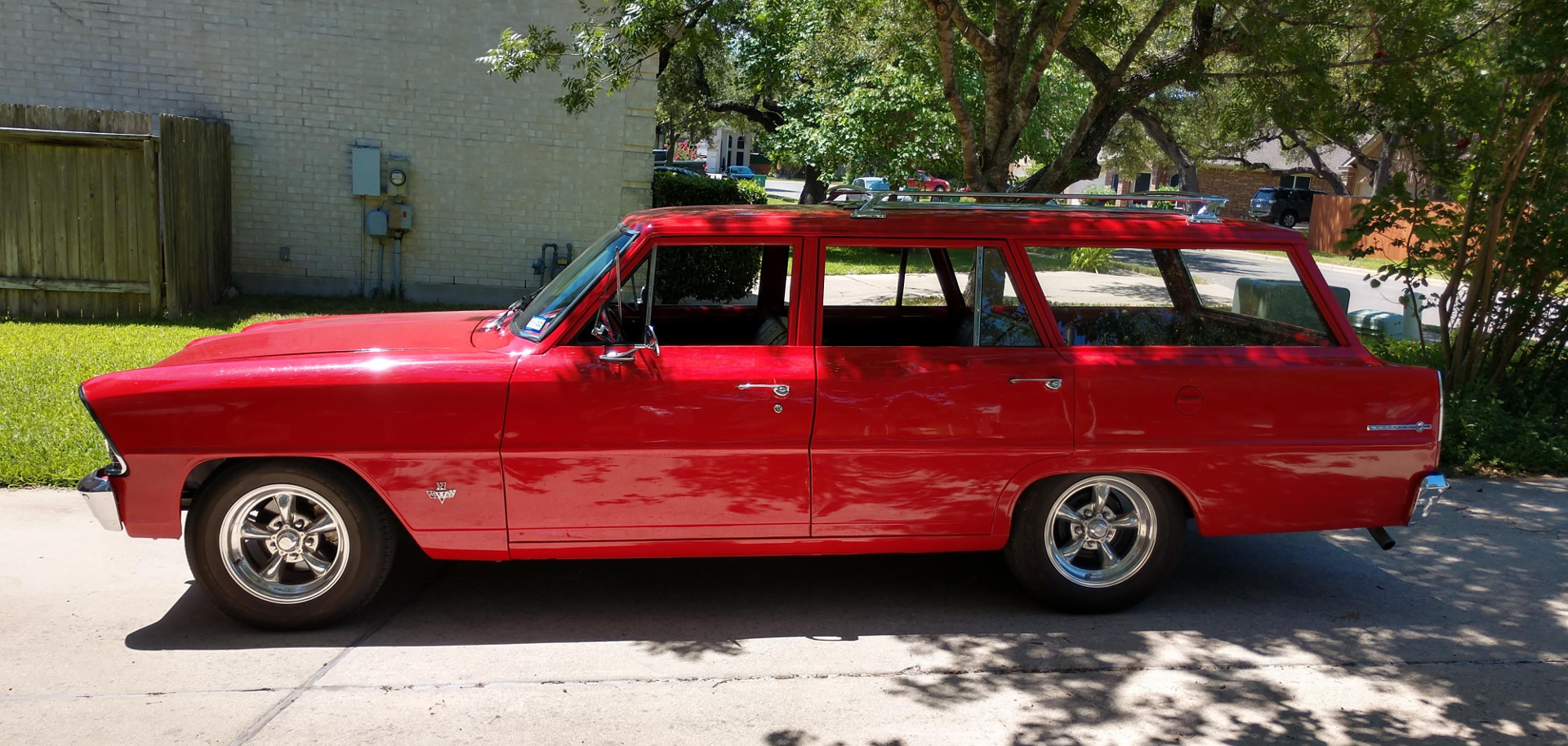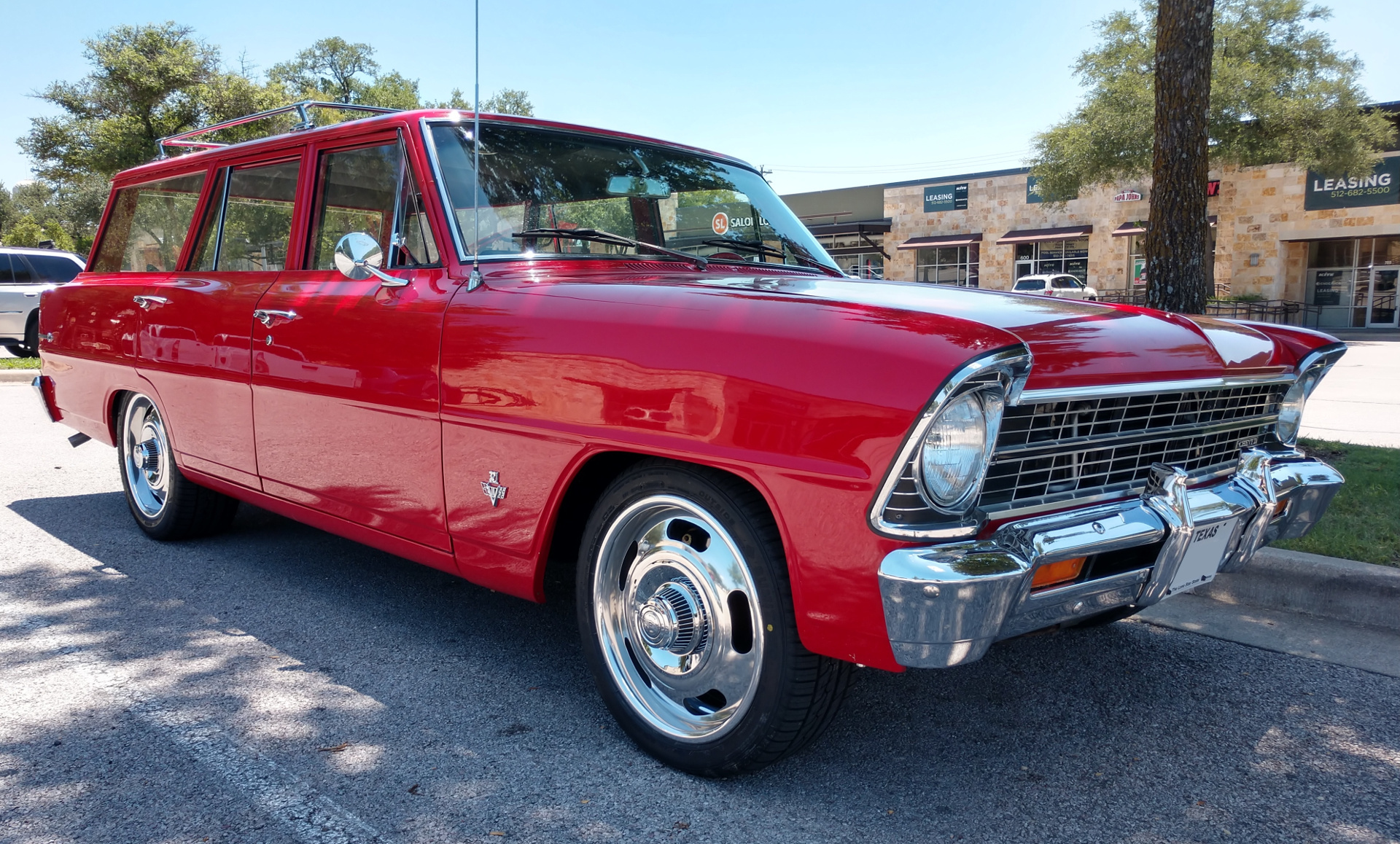1967 Chevy II Wagon Wheels

This car came to me with a handsome and popular set of American Racing Torq Thrust II wheels in 15x6". The high polish complemented the red paint well in my opinion. However, the backspacing did not fit the front of the car well, especially with the extra 3/8" ×2 track width added to the front by the Chevelle disc brake rotors. Add to that the 70-series tires that were taller than stock — 205/15/60 would have been a lot closer. Finally, the car had been lowered with these ill-fitting wheels and tires. Naturally, it looked great, but the result was a very no-fun rubbing on the driver's side front fender about halfway to right steering lock and even a little on the passenger side, 1967 factory tolerances and 55 years of driving being what they are.
So I fixed it.
The obvious solution was to get the correct size wheels and tires. The wisdom of the Internet on Steve's Nova Site suggests the following. I added a conservative 1/4" to make up for the 3/8" added by the front rotors.
| Wheel | Backspacing | Offset | Tire | |
|---|---|---|---|---|
| Rear | 17x8" | 5.25" | ET19 | 245/45/17 |
| Front | 17x7" | 4.75" | ET19 | 215/45/17 |
| Front + OE disc brakes | 5" | ET25 |
I very much like the original '60s Chevy Rally steel wheels and American Racing offers an alloy reproduction of them in modern alloy called the VN327 Rally. The size also makes it a lot easier to find tires these days. Unfortunately, no one makes wheels in the ideal backspacing for the first and second generation Chevy II, so these would have to be custom built. That makes them expensive, but with the added benefit of a strong, forged barrel.

I'm not completely sold on the 17" wheels on a '60s classic. The size looks a little out of place, but at least the provenance is there. And I wish these had a little more depth to the face of them, but that's the cost of getting the correct offset for the maximum width tires for the GM X-body.
An unusual aspect of these particular AR wheels puts the valve stem on the inside. I wasn't expecting this. Maybe it has something to do with the way the centers are welded to the barrels? These barrels are flipped around backward from what one normally expects leaving plenty of room for a chosing the perfect offset. Since they're flipped, it's easier to bead tires from the back, or so it witnessed. One upside to this weird arrangement is there's no unsightly valve stem showing on the outside. I guess. Time will tell how annoying this is, but I strongly doubt I would ever choose this configuration on purpose.
The 6" width of the inexpensive Torq Thrust wheels couldn't fit more than a P205 tire. With the correct 5" backspacing on the 17x7" fronts and 5.25" BS on the 17x8" rears, I can fit 215/45/17 tires on the front and the large circumference 245/45/17 tires on the back — wider tires and, so far, no rubbing issues!
However, FedEx has been quite busy lately and ended up chucking one of my rear wheels on the truck headed back to the vendor instead of the truck to my house with the rest. So I received three wheels at first and ended up cancelling my appointment to mount the tires that weekend. The full fitment story has yet to be written, but I did check the three I received had the right bolt pattern and a straight edge suggested my offset calculations were are least close to correct.
The factory 14x5" wheels and 185/75/14 tires are long gone.
Chevy's wacky front suspension geometry induces toe in at the top of suspension travel and a surprising amount toe out in compression, which is where the lowering left things. Already the large circumference tires were at the leading edges of the fenders, so dialing in any more negative toe was not an option. I'm still working on this (see the suspension section) to determine a final ride height based on what adjustment or aftermarke control arms remain available to me. Hopefully the new, smaller circumference front tires will help with this. The whole suspension remains in development.














